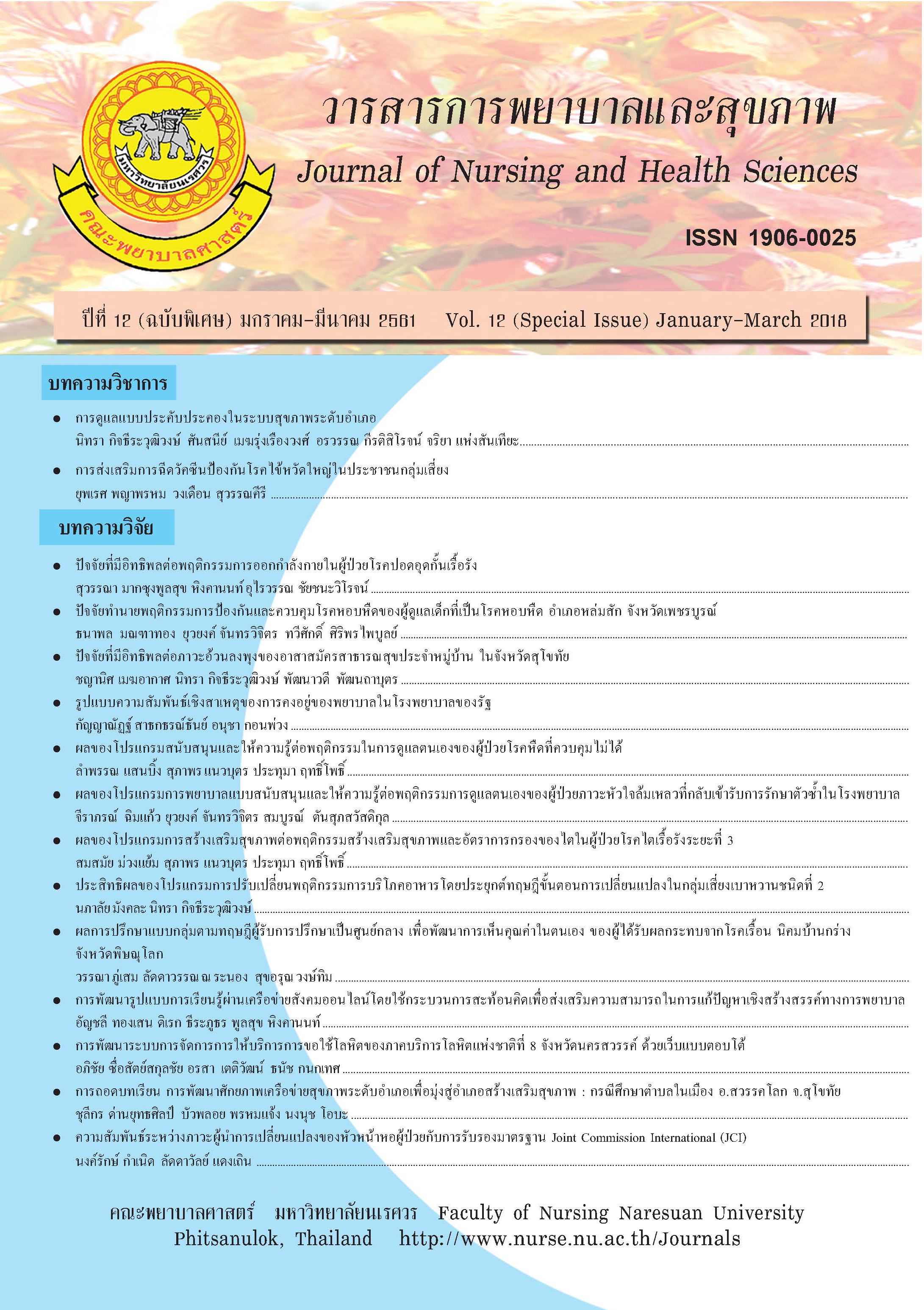Effects of Health Promotion Program on Health Behavior and Estimated Glomerulus Filtration Rate among Patients with Chronic Kidney Disease Stage 3
Main Article Content
Abstract
This quasi-experimental research was conducted to assess the effects of a health promotion program on health improvement behavior of, and estimated glomerulus filtration rate among, patients with stage 3 chronic kidney disease. Sixty patients diagnosed with chronic kidney disease were selected and randomly assigned into a control group and an experimental group each with thirty patients. Participants in each group were matched by age, gender and level of kidney disease. The experimental group received the health promotion program over 12 weeks, while the control group received routine nursing care. Data collection used a demographic data questionnaire, a health promotion questionnaire and a record of the estimated glomerulus filtration rate of each patient. Use an Enzymatic Analyzer in an eGFR computational lab using the CKD-EPI formula.The data were analyzed by using descriptive statistics, independent t-test and paired t-test. Our results showed that the experimental group had a post-program mean score of personal health responsibility, physical activity, nutrition, interpersonal relations, spirituality, stress management and total health promotion behavior significantly higher than before intervention. The experimental group results were also significantly higher than those of the control group post-intervention (p-value = .05). Furthermore, the average estimated glomerulus filtration rates of the experimental group participants after participating in the program were significantly higher than pre-intervention. The comparison between the experimental and control groups for average estimated glomerulus filtration were even more significant, in that, while the pre-intervention rates of each group were the same, the values for the control group either remained constant, or actually fell. Given this, the post-program difference is even more significant, indicating further the importance of the health promotion program. Statistical significance was calculed with p-value = .05. These results showed that participation in a health promotion program of this nature improves all the aspects of health improvement behaviour measured, which include personal health responsibility, physical activity, nutrition, interpersonal relations, spirituality, stress management and total health promotion behavior, and also the important glomerulus filtration rate of the patients. We can confidently recommend the participation of patients with stage 3 chronic kidney disease in this program.
Article Details
References
ผลของโปรแกรมส่งเสริมสุขภาพต่อดัชนีมวลกาย
เส้นรอบเอวและระดับฮีโมโกลบินเอวันซีใน
ผู้ป่วยโรคเบาหวานชนิดที่ 2 ที่พึ่งได้รับการวินิจฉัย.
วารสารการพยาบาลและการดูแลสุขภาพ (Journal
of Nursing and Health Care), 32(2), 47-56.
กมลธร วัสสา, และวิพร เสนารักษ์. (2559). ผลของ
โปรแกรมส่งเสริมสุขภาพต่อระดับความดันโลหิต
ดัชนีมวลกายและเส้นรอบเอวในผู้ที่มีภาวะ
Prehypertension The Effect of Health
Promoting Program on Blood Pressure, Body
Mass Index and Waist Circumference in
Prehypertensive Person. วารสารการพยาบาล
และการดูแลสุขภาพ (Journal of Nursing and
Health Care),33(4), 65-73.
กาญจนา เหลี่ยมการค้า. (2556). ผลของโปรแกรมการ
สร้างเสริมสุขภาพต่อพฤติกรรมสุขภาพและ
ปัจจัยเสี่ยงที่ปรับเปลี่ยนได้ในประชาชนกลุ่ม
เสนี่ยงโรคหลอดเลือดหัวใจ. (วิทยานิพนธ์
พยาบาลศาสตรมหาบัณฑิต สาขาวิชา การพยาบาล
เวชปฏิบัติชุมชน). บัณฑิตวิทยาลัย, มหาวิทยาลัย
นเรศวร.
จรูญรัตน์ รอดเนียม, สกุนตลา แซ่เตียว, และวรวรรณ
จันทวีเมือง. (2557). การรับรู้ประโยชน์การรับรู้
อุปสรรคและการรับรู้ความสามารถของตนเอง
กับพฤติกรรมสร้างเสริมสุขภาพและภาวะ
สุขภาพของนักศึกษาพยาบาล.วารสารพยาบาล
กระทรวง สาธารณสุข (Nursing Journal of The
Ministry of Public Health),23(3), 88-97.
ทิศนา แขมมณี. (2555).14 วิธีสอนสำหรับครูมืออาชีพ
พิมพ์ครั้งที่ 11.กรุงเทพฯ : จุฬาลงกรณ์
มหาวิทยาลัย.
เนวรัตน์ นวกุลพันธ์. (2555). ผลของโปรแกรมการ
สร้างเสริมสุขภาพต่อพฤติกรรมสุขภาพและ
การควบคุมโรคหลอดเลือดสมองของประชาชน
กลุม่ เสี่ยง. (วิทยานิพนธพ์ ยาบาลศาสตร มหาบัณฑิต
สาขาวิชาการพยาบาลเวชปฏิบัติชุมชน) บัณฑิต
วิทยาลัย, มหาวิทยาลัยนเรศวร.
เปรมใจ สุขศิริ และคณะ. (2553). การประยุกต์แบบแผน
การส่งเสริมสุขภาพของเพนเดอร์ในการลดภาวะ
ไขมันในเลือดของกำลังพล กองทัพเรือ.
วารสารพยาบาลสาธารณสุข, 24(1), 28-35.
พงศธร คชเสนี. (2558). Essentials in hemodialysis.
กรุงเทพฯ: สมาคมโรคไตแห่งประเทศไทย.
วิยะการ แสงหัวช้าง. (2556). ผลของการให้ความรู้โดยใช้
กระบวนการกลุ่มและการติดตามทางโทรศัพท์
ต่อความรู้และพฤติกรรมการป้องกันโรคหลอด
เลือดสมองในผู้สูงอายุเจ็บป่วยเรื้อรัง.วารสาร
ศูนย์การศึกษาแพทย์ศาสตร์คลินิกโรงพยาบาล
พระปกเกล้า (The Journal of Prapokklao
Hospital Clinical Medical Education),30
(4), 260-273.
สมาคมโรคไตแห่งประเทศไทย. (2558). แนวทางเวช
ปฏิบัติสำหรับโรคไตเรื้อรังก่อนการบำบัด
ทดแทนไต. (พิมพ์ครั้งที่1). กรุงเทพฯ: สมาคม
โรคไตแห่งประเทศไทย.
สิริชยา อังกูรขจรและสุนิดา ปรีชาวงศ์. (2557). ผลของ
โปรแกรมการสร้างเสริมสุขภาพตามแนวคิด
ของเพนเดอร์ต่อความร่วมมือในการรับประทาน
อาหารและยาของผู้ป่วยวัยผู้ใหญ่ที่มีภาวะหัวใจ
ล้มเหลว.วารสารพยาบาลโรคหัวใจและทรวงอก
(Journal of Nursing and Health Care), 25(2),
77-89.
สุปราณี กิติพิมพ์, วันเพ็ญ ภิญโญภาสกุล, และอรวมน
ศรียุกตศุทธ. (2013). ปัจจัยทำนาย พฤติกรรม
สร้างเสริมสุขภาพในผู้ป่วยโรคไตเรื้อรังระยะ
แรกและระยะปานกลาง. วารสารพยาบาล (Thai
Journal of Nursing),62(4), 35-42.
สุนันทา คำพอ. (2540). การติดต่อสื่อสารกับผู้ป่วย และ
ครอบครัวทางโทรศัพท์.ใน ชนิตา มณีวรรณ
(บรรณาธิการ), คู่มือการปฏิบัติการพยาบาล
ที่บ้าน (หน้า 197-200). กรุงเทพฯ: บรรณศิลป์
พริ้นติ้ง
สุพิมพ์ อุ่นพรม. (2550). ผลของโปรแกรมการให้ความรู้
ด้านสุขภาพต่อพฤติกรรมสร้างเสริมสุขภาพ
ของประชาชนกลุ่มเสี่ยงโรคเบาหวานวัยผู้ใหญ่.
วารสารพยาบาลศาสตร์มหาวิทยาลัยนเรศวร.
1(1), 100-111.
อิษณี พุทธิมนตรี. (2550). Role of Nurse in CKD
Prevention. ในชมรมการพยาบาลโรคไตแห่ง
ประเทศไทย(บรรณาธิการ), Management of
Diabetic Patients with Chronic Kidney Disease,
(หน้า 1-12). กรุงเทพฯ: ชมรมการพยาบาลโรคไต
แห่งประเทศไทย.
Health Data Center.(2560). กลุ่มรายงานข้อมูลเพื่อตอบ
สนอง service plan สาขาไต. Retrieved from
https://hdcservice.moph.go.th/hdc/main/
index_pk.php
Lozano, R., Naghavi, M., Foreman, K., Lim, S., Shibuya,
K., Aboyans, V., &AlMazroa, M. A. (2013).
Global and regional mortality from 235 causes
of death for 20 age groups in 1990 and 2010: a
systematic analysis for the Global Burden of
Disease Study 2010. The Lancet, 380(9859),
2095-212
Pender,N.J.,Murdaugh,C.L.,andParsons,M.A. (2011).
Health Promotion In Practice.(6thed). Upper
saddle River,NJ:Pearson Education


